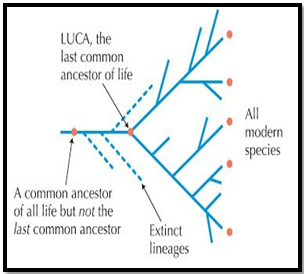UNRAVELLING ORIGINS: LUCA AND EVOLUTIONARY MYSTERIES
Why in the news?
LUCA’s origins and the molecular clock’s role in evolutionary timelines are making headlines for their insights into life’s beginnings.
source:researchgate
About LUCA and Evolutionary Insights:
Last Universal Common Ancestor (LUCA):
- LUCA Definition: Last Universal Common Ancestor (LUCA), also known as Last Universal Ancestor (LUA), is the common ancestor of all life on Earth.
- Hypothesised ancestor of all life forms, including bacteria, archaea, and eukarya.
- Estimated to have existed around 4.2 billion years ago based on molecular clock analysis.
- Phylogenetic Basis: LUCA’s existence is inferred from shared genetic ancestry among all organisms.
- Role in Evolution: It represents the root of the phylogenetic tree, giving rise to diverse categories of life forms on Earth.
Molecular Clock Theory:
- Developed in the 1960s by Zuckerkandl, Pauling, and Kimura to estimate evolutionary timelines.
- Calibrated using genetic mutations and fossil records to trace evolutionary events.
| Understanding Origins of Life Theories:
Oparin-Haldane Hypothesis (1920s):
Meteorite Theory:
|





